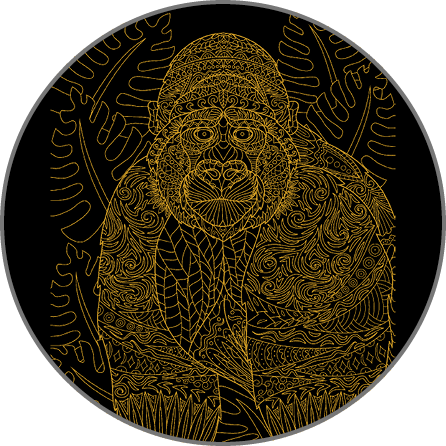Monkey Mandala Animal Art [4]
![]() A Granite Bay Design Microsite: Animal Mandala
A Granite Bay Design Microsite: Animal Mandala
The Monkey
![]()


The Monkey’s Cultural Significance
Monkeys have always been part of popular culture. They are part of very early religions including Hinduism and Buddhism. They are symbols too in order to ward off evil. The see no evil, speak no evil, and hear no evil shows three Monkeys. One has a hand over his eyes, one a hand over his ears, and one a hand over his mouth. This continues to be a very popular symbol people have to remind them to be cautious with what they take part in with other members of society. There is plenty of art work that has Monkeys in it. Most jungle scenes show them observing what is going on around that area. They seem to be a good leader for the overall ecosystem where they live in such art work. Video games are another sector where you will find Monkeys in popular culture with a new twist. The Monkey is one of the loved animals that draw people to the zoo too. They come to watch them play and interact with each other. When there is a young one around it seems that people will flock to this exhibit all day long.

The Monkey as Spirit Animal
Curiosity and exploration: Monkeys always explore and learn, ready to take on new challenges and experiences. They symbolize our willingness to seek new opportunities and go after the things that matter most. • Social awareness: The monkey spirit animal is associated with social intelligence and group dynamics. They remind us of the importance of tuning into the needs of others and building strong relationships with those around us. • Adaptability to any environment: Monkeys are supremely adaptable and capable of surviving in various climates and habitats. This capacity can translate into success in our lives, encouraging us to be flexible and resilient in facing adversity. • Dexterity, agility, and playful nature: Monkeys are incredibly agile and active animals known for their impressive athleticism. They can symbolize our physical prowess and vitality, inspiring us to stay active and enjoy life’s joyful moments by awakening our inner child. • Problem-solving skills and resourcefulness: Monkeys are intelligent creatures, and they often find creative solutions to the challenges they encounter. Their spirit can remind us of our capacity to deal with life’s obstacles inventively. • Lightheartedness and intelligence: 0Monkeys have a unique spirit, embracing playfulness and mischief without taking life too seriously. They can inspire us to cultivate a greater balance between work and play and a greater appreciation for the lighter moments in life.

Monkeys in Japanese Culture
The Japanese cultural meaning of the monkey has diachronically changed. Beginning with 8th-century historical records, monkeys were sacred mediators between gods and humans; around the 13th century, monkeys also became a “scapegoat” metaphor for tricksters and dislikable people. These roles gradually shifted until the 17th century, when the monkey usually represented the negative side of human nature, particularly people who foolishly imitate others. Japanese anthropologist Emiko Ohnuki-Tierney explains the idiom saru wa ke ga sanbon tarinai (猿は毛が三本足りない, “a monkey is [a human] minus three pieces of hair”): The literal meaning of this saying is that the monkey is a lowly animal trying to be a human and therefore is to be laughed at. However, the saying is understood by the Japanese to portray the monkey as representing undesirable humans that are to be ridiculed.

Monkeys in Bronze Age Art
As far as archaeologists know, Asian monkeys weren’t trotting the globe during the Bronze Age. That’s why a millennia-old Greek painting of a gray langur—a primate native to the Indian subcontinent—was surprising enough to stop researchers dead in their tracks. Archaeologists and primatologists re-analyzing wall paintings found in Akrotiri, a Minoan settlement on Thera (modern-day Santorini) buried by volcanic ash around 1600 B.C., have uncovered evidence that Bronze Age Greek artists knew of—and may have even seen—monkeys whose native habitat was thousands of miles away. Their findings, newly published in the journal Primates, hint that ancient cultures were more intertwined than previously thought. Eager to exchange ideas, artists or merchants may have journeyed far from home; eventually, the fruits of these wanderers’ travels were immortalized in paint.

About the Animal Mandalas
Animal mandalas range from simple designs featuring cute little puppies and kittens that appeal to children, to detailed works of art ripe with spiritual symbolism. As an artistic tool for children, animal mandalas can supplement learning and provide an outlet for creative expression. For adults, the symbolism and meaning of the design may be more important. Consider the use of the mandala before you choose an animal design.

